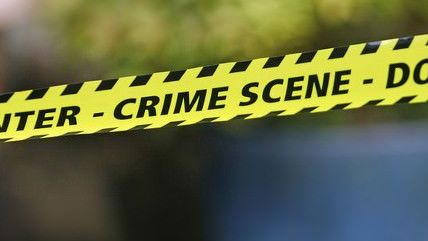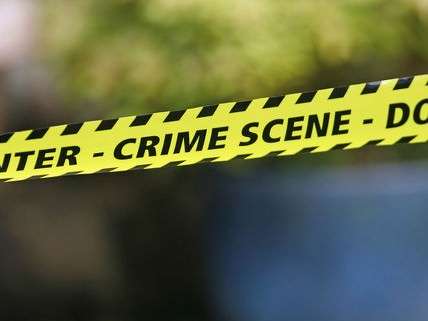Washington Post Undercounts Number of Unarmed Black Men Killed by Cops, Misses Bigger Picture
Solutions to police violence have to focus on systemic problems, not demographic appearances.


A year ago yesterday, the killing of Michael Brown by Darren Wilson, a police officer in Ferguson, Missouri, catapulted the issue of police violence onto the national stage. After Brown's death, subsequent cases of killings by police received more attention than they likely otherwise would've.
Even killings that happened before Brown's, like that of Eric Garner, who was killed by police on Staten Island last July after being accused of selling loose, untaxed cigarettes, garnered more attention afterward. Garner's death saw protests in New York CIty and around the country on a scale not seen when police shot and killed 18-year-old Ramarley Graham after chasing him into his grandmother's house over a small amount of marijuana. Freddie Gray, Walter Scott, and even Sandra Bland subsequently became household names. If their deaths had occurred a few years earlier they would join the thousands of names of people killed by police unknown to Americans, like Graham, or David Lee Turner or Erik Scott or Ernesto Duenez or Bobby Bennett or Timothy Russell and Malissa Williams or even Seth Adams.
This year, victims of fatal police violence are counted by the media in a way they never have before. Over the weekend, the Washington Post ran a long piece under the headline "Black and Unarmed" about the 24 unarmed black men fatally shot by police this year, based on their ongoing analysis of their database on fatal police shootings. The Post does not offer a link to its database itself, but at least one other outlet has its own publicly available database. The Guardian has been collecting news reports of police killings this year and making the database available to the public online as a feature called "The Counted." The Guardian counts 26 unarmed black men fatally shot by police.
It includes six cases not in the Washington Post's report, those of Denzel Brown, Sam Holmes, Kevin Judson, Glenn Lewis, Demeris Turner, and Andrew Williams, while categorizing four cases in the Post's report as something other than an unarmed black man fatally shot by cops. The Guardian lists Albert Davis' race as unknown and Victor Larosa's armed status as unknown. Lavall Hall and Bobby Gross are listed as "armed (other)" because they were alleged to have been armed, respectively, with a broom stick and a tree branch. The Post says it considers victims of police shootings holding "an object unlikely to inflict serious injury" as unarmed.
Nevertheless the Post omits 23 other black men shot by police that The Guardian reports were armed with something other than a gun or a knife. The most recent, Darius Graves, barricaded himself in a motel room after being chased for allegedly committing a robbery. Police threw tear gas into his motel room and then shot him when he ran out with a steel pole.
By focusing on fatal police shootings, the Post missed about 28 other unarmed black men killed by police in some other manner. By focusing only on unarmed black men, the Post can say that the number represents "a surprisingly small fraction of the 585 people shot and killed by police through Friday evening." The Guardian counts 704 people killed by police in the U.S. in 2015—about 83 percent of whom were shot. But less than half of the unarmed black men who were killed by police were shot. Ten died in police custody, including Jonathan Sanders and Freddie Gray. Four were struck by police vehicles—in each case police say it was an accident but in at least two cases, that of Bernard Moore and Bryan Overstreet, the families are questioning the police narrative. Fourteen unarmed black men died after being Tased.
Of the two black women killed by police this year, one was among four people fatally struck by police vehicles in New Jersey alone, and another, Natasha McKenna, died after being Tased while shackled in a Virginia county jail. While authorities insisted her death was accidental, and that psychoactive medications and her state of "excited delirium" contributed to it, the jail temporarily stopped using Tasers after the incident.
The Washington Post points out that its 24 fatal police shootings of unarmed black men make up 40 percent of all shootings while black men make up only 6 percent of the U.S. population. But there have been no reports of police shooting and killing an unarmed black woman this year. They make up 6 or 7 percent of the population too, but no one would suggest there's not a problem with policing when it comes to black women. More than 90 percent of the victims of fatal police shootings are men,
The Post says it found unarmed black men are seven times more likely to be shot and killed by police, an incredible statistic that points to a big racial problem in policing, and the hiring and firing thereof. But were unarmed black men killed by police at the same rate as unarmed white men, there would still be more than 40 fatal police shootings of unarmed people in the U.S. this year. There have actually been 65—while 85 other unarmed people died in police custody some other way, more from Tasers than any other method.
What most of these cases have in common, across race, gender, and age, is that the officers involved get away with it. Cases like Freddie Gray's and Walter Scott's, where police officers were charged criminally, are the exception. Police officers across the country enjoy a wide array of privileges "civilians" involved in homicides don't. Even in the case of Freddie Gray, where the police officers had 10 days to speak to investigators about what happened, the six cops facing charges related to Gray's death all remain on the payroll of the Baltimore Police Department.
Police officials and police unions complain that the new national mood is turning police officers into targets, on the streets and in the courts. The Washington Post points out 18 cops have been shot and killed in the line of duty—but not that this is a 25 percent decrease from last year, or that police work is getting safer. And where police unions and officials argue there's a problem of overprosecuting cops—setting aside for a moment the absolute absurdity of this argument when most cops don't face charges after killing someone—the employment protections they've carved out for law enforcement have contributed to the problem. In many jurisdictions it's almost impossible to fire a cop absent a criminal conviction. All six Freddie Gray officers, again, are still employed. A lack of meaningful accountability for homicidal misconduct helps create an environment where such misconduct will of course continue.
The fetishization of the racial aspect of police violence at the expense of any other factors by much of the mainstream media means those systemic problems, and others, that contribute to police violence are ignored. The case of Zachary Hammond, an unarmed white teenager shot during a sting over 10 grams of marijuana, for example, illustrates the drug war's role in police violence. Many police shootings, of people of all races, armed and unarmed, are drug-related. Drug-related violence, state or otherwise, is almost entirely fueled by the government's classification of drugs as illegal substances. Hammond was white, so he's not on the Post's list. But The Root covered Hammond's case last week, pointing out that the "All Lives Matter" crowd had not drawn attention to Hammond, while police reform activists operating under the banner of "Black Lives Matter" had. Hammond's attorney complains the case has not received as much attention as its controversial nature deserves because the dead unarmed teenager is white.
As Jacob Sullum notes, the main lesson in Hammond's case is the depravity of the drug war, and the support that war continues to enjoy. Sullum highlighted one quote from a resident responding to the fatal shooting: "We're so thankful here in Oconee County that our police departments and sheriffs and things like that, that they're on top of the drug problems and trying to eliminate all drugs and everything." There is a statement that is pretty typical of the white community. The All Lives Matter crowd The Root refers to isn't one that's interested in police violence as it applies to all races, but one that tries to downplay state violence because of the lives the state saves by, say, throwing people in jail for the things they put in their bodies. Eliminating "all drugs and everything."
The mainstream media's narrow interest in police violence as a racial problem misses a police violence epidemic that crosses racial and class lines. Hammond's cases is pretty close to what Toni Morrison said would be an indicator of the end of racism—an unarmed white teenager shot in the back. And Hammond isn't the first unarmed white teenager killed by cops who got away with it. It doesn't mean racism is over. Just as if police killed unarmed people of all races at the same rate—even if that rate were the one they currently kill unarmed white people at—there would still be a police violence problem.
Until cops can be fired for displaying malicious tendencies—even before they kill—until cops are no longer ordered to go into largely poor communities to zealously enforce petty laws meant at raising revenue, until the community-police relationship is really treated as one of master-servant, in that order, there will continue to be plenty of names to count and talk about.


Show Comments (64)